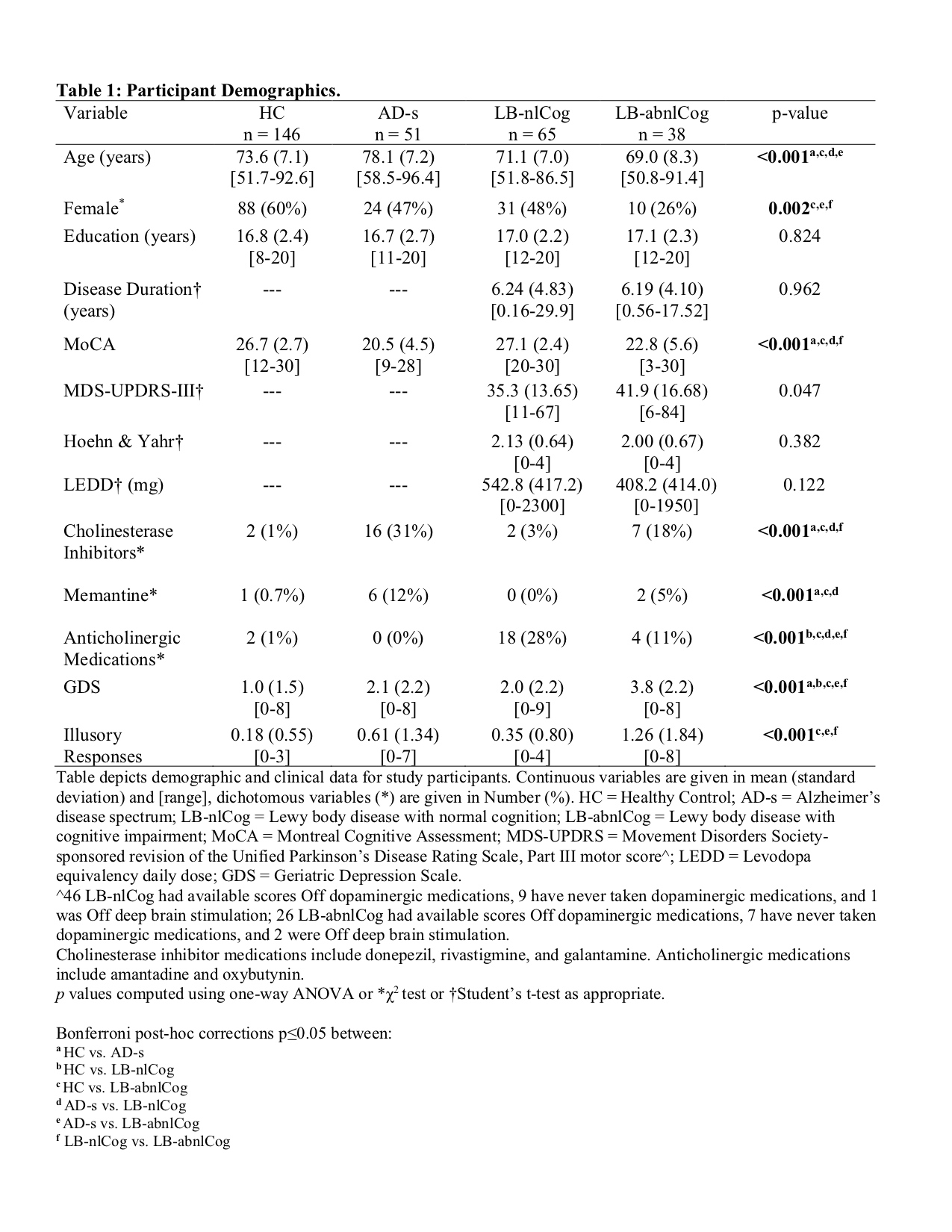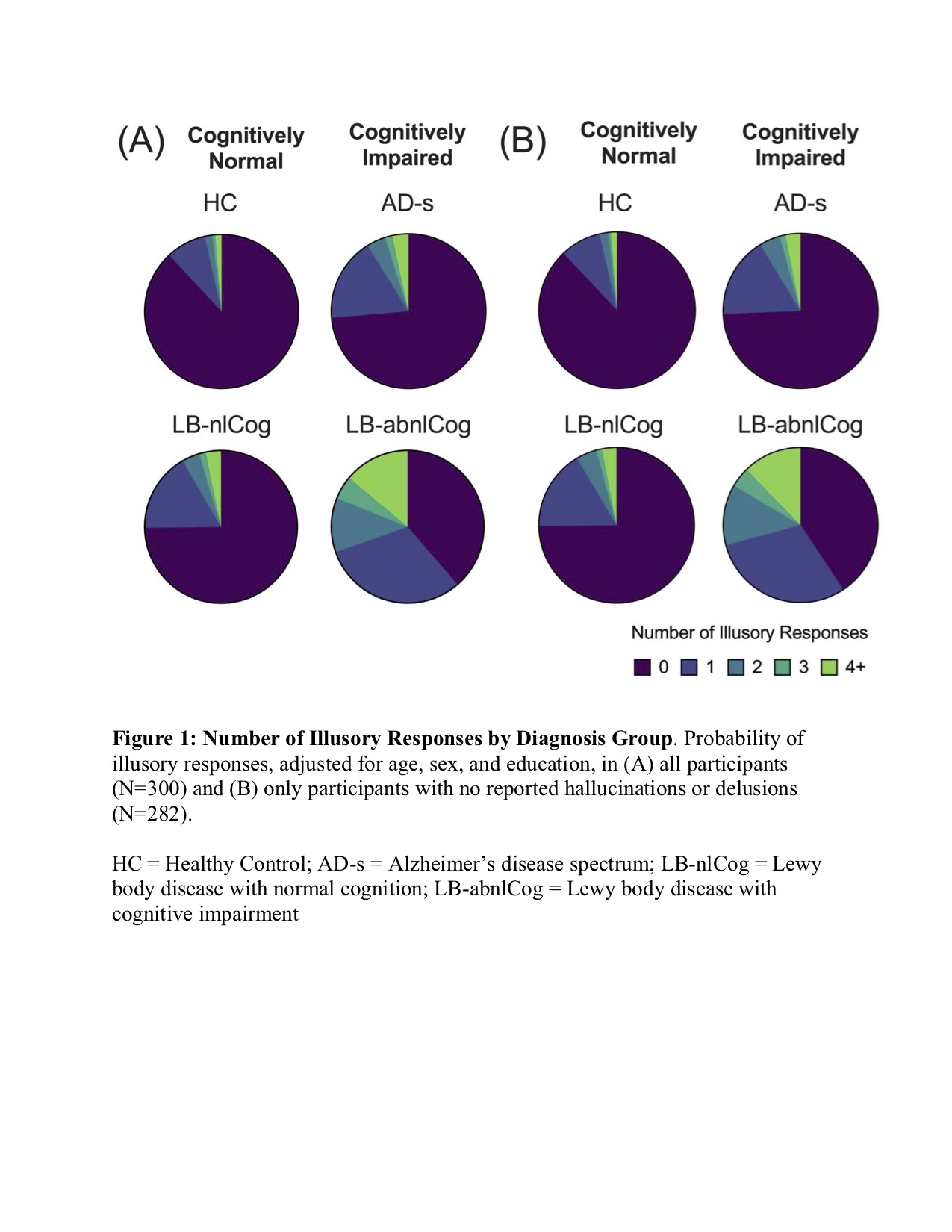Objective: To study pareidolias in patients across the Lewy body disease-spectrum, including those without psychosis.
Background: Pareidolias are specific illusions of faces and objects perceived in formless visual stimuli [1]. Further studies are needed to understand whether illusory responses occur in earlier stages of disease or in patients without psychosis across the Lewy body disease (LBD) spectrum, such as Parkinson’s Disease with and without cognitive impairment.
Method: We studied the NACC Noise Pareidolia Task-Short Form from the LBD Module [2] in 300 participants who completed comprehensive motor and cognitive assessments with consensus diagnostic adjudication. We included 65 LBD with no cognitive impairment (LB-nlCog), 38 LBD with cognitive impairment (LB-abnlCog), 51 Alzheimer’s disease-spectrum (AD-s), and 146 Controls. Pairwise between-group comparisons examined the impact of diagnosis on number of illusory responses. Ordinal regression analysis compared the number of illusory responses on the Noise Pareidolia Task across diagnosis groups, adjusting for age, sex, and education. Analyses were repeated after removing participants with reported hallucinations or delusions.
Results: See Table 1 for diagnosis group demographic characteristics. LB-abnlCog were more than 10 times more likely than Controls and about 4-5 times more likely than AD-s and LB-nlCog participants to endorse illusory responses. The probability of endorsing one or more illusory response was 61% in the LB-abnlCog group, compared to 26% in AD-s, 25% in LB-nlCog and 12% in Control participants (Figure 1A). After excluding participants with reported hallucinations or delusions, the probability of endorsing one or more illusory responses was 59% in LB-abnlCog and remained unchanged in the HC, AD-s, and LB-nlCog groups (Figure 2B). In LBD participants without hallucinations or delusions, 52% of those with mild cognitive impairment and 67% with dementia endorsed at least one illusory response.
Conclusion: Illusory responses are common in cognitively impaired LBD patients, including those without any reported psychosis. The Noise Pareidolia Task does not distinguish between Lewy body and Alzheimer’s disease patients until there is measurable cognitive impairment in the LBD patients, suggesting that early, unobtrusive pareidolias might arise in conjunction with cognitive decline in LBD.
References: [1] The psychosis spectrum in Parkinson disease. Ffytche D, Creese B, Politis M, Chaudhuri K, Weintraub D, Ballard C, Aarsland D. Nat Rev Neurol. 2017 Feb; 13(2): 81–95.
[2] https://www.alz.washington.edu/WEB/forms_lbd.html
To cite this abstract in AMA style:
M. Shahid, A. Rawls, V. Ramirez, S. Ryman, V. Santini, L. Yang, S. Sha, J. Hall, T. Montine, A. Lin, L. Tian, V. Henderson, B. Cholerton, M. Yutsis, K. Poston. Illusory responses across the Lewy body disease spectrum [abstract]. Mov Disord. 2022; 37 (suppl 2). https://www.mdsabstracts.org/abstract/illusory-responses-across-the-lewy-body-disease-spectrum/. Accessed April 21, 2025.« Back to 2022 International Congress
MDS Abstracts - https://www.mdsabstracts.org/abstract/illusory-responses-across-the-lewy-body-disease-spectrum/


